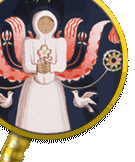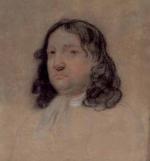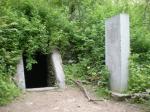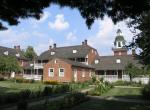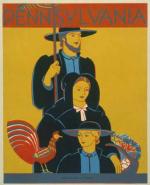Overview: Set Apart: Religious Communities in Pennsylvania
"All men have a natural and indefeasible right to worship Almighty God according to the dictates of their own consciences; no man can of right be compelled to attend, erect, or support any place of worship... against his consent."
William Penn, Declaration of Rights, 1682
When William Penn issued his Declaration of Rights in 1682, the idea that individuals have a natural right to worship according to the dictates of their own conscience was a radical, even subversive notion. No nation in Europe embraced it. Indeed, most used the full force of the law to punish religious "separatists" who broke from established, or state-affiliated, churches. Fines, imprisonment, and execution, however, did not deter Christians who believed they were called by God to embrace different forms of worship and belief.
In the 1680s Europe was still reeling from the aftershocks of the Protestant Reformation, that great split in Christianity that had unleashed one hundred years of religious war and remade the map of Europe in the sixteenth and seventeenth centuries. After Henry VIII broke from the Roman Catholic Church and in the 1530s created the Church of England over which he, the King, presided, England, too, experienced generations of religious conflict.
In the aftermath of the bloody civil war of the 1640s, when Oliver Cromwell and his Puritan and Presbyterian supporters dethroned and then beheaded England's King Charles I, religious dissenters were free to worship more openly and varied religious enthusiasms took hold. For the future colony of Pennsylvania, and for the religious communities that would find haven there, the most important group of dissenters to flourish during this period was the Religious Society of Friends, better known as the Quakers.
From its start in 1647, when founder George Fox exhorted his neighbors to reject the empty formalism and rituals of the Church of England and seek a personal relationship with God, the Society of Friends threatened religious and political authorities. Believing that God existed in all people, Friends rejected the trained clergy and structured services of the Anglican Church. Instead they gathered in meetings where they sat in silence until a Friend was moved by God to speak.
Friends' trust in this Inner Light gave rise to other radical notions. In an effort to follow the model and teachings of Christ, they refused to bear arms, remove their hats before civil or religious authorities, swear any form of oath, or tithe. Fortified by the conviction that they were doing God's will, they wrote inflammatory pamphlets condemning corruption in the Anglican church, interrupted Anglican church services to loudly promote their views, adopted a different style of dress, permitted women to speak - and when so moved to preach - in meeting, and in other ways antagonized religious and civil authorities.
To discourage and suppress these annoying and disrespectful radicals, British courts fined, flogged, and imprisoned Friends by the thousands. Holding to the example of the apostles who had suffered for the name of Jesus, hundreds chose to die in prison rather than renounce their faith.
The Friends' more popular name of Quaker appeared during this period of persecution. According to one version of the story, an unrepentant George Fox, dragged into court yet again for challenging the Church of England, lectured the judge to "tremble at the word of the Lord," to which the judge dryly replied that it was Fox who should "quake" in his presence. Another version had the judge admonishing Fox to "quake in the face of the Lord." Either way, the name Quaker stuck and became the popular term for the Friends.
Shortly after founding the Society of Friends, Fox began to investigate the possibility of establishing a haven for Quakers in North America. In 1660 Quaker Josiah Cole traveled to territory north of Maryland to explore purchase of land from the Susquehannocks or Delaware. In 1672, Fox made his own tour of Britain's American colonies to seek a new home for his besieged flock. Following a scouting trip to the colony of West Jersey - present-day New Jersey - a group of Friends established the village of Salem in 1675, and Fox urged his friend and supporter William Penn to sponsor the immigration of 800 more Quakers.
Born in 1644, William Penn had joined the Quakers in his teens and soon became one of their most eloquent spokesmen and effective defenders. The son of Admiral William Penn, a celebrated war hero and commander of the British fleet, the junior Penn stunned English upper-class society when he converted from the established Church of England to this much-maligned sect. In the years that followed Penn agitated for Quakers' political rights and criticized English religious authorities, on occasion landing in prison for his efforts.
Penn was unable to provide much help for Fox in 1675, but when the Admiral died in 1680, the thirty-six-year-old Penn came into possession of a debt of £16,000 that the crown owed to his father for services rendered. In 1681 Penn requested that Charles II grant him the last large unclaimed territory on the North American seaboard as payment for the debt. When Charles agreed and awarded him a province of more than 40,000 square miles, Penn became the largest private landowner in the whole of Great Britain.
In Pennsylvania, as his new province was called, Penn was determined to create not just a refuge for Quakers, but a "Holy Experiment," where religious freedom would be the cornerstone of the new social order. Although Penn's royal charter had made him the governor as well as proprietor of his colony, rather than install himself as a feudal lord, he helped write and then agreed to a Frame of Government that allowed for freedom of conscience in religious matters and recognized the separation of church and state.
To attract settlers to Pennsylvania, Penn traveled throughout the continent, promoting his colony to both Quakers and other religious groups suffering persecution for their beliefs. Many accepted Penn's invitation to come to the New World, and Pennsylvania quickly became a multinational and multi-religious colony unlike any other in North America. Rich with natural resources and economic opportunities, it attracted Quakers, as well as English Anglicans, French Huguenots, Scottish and Scots-Irish Presbyterians, Irish Catholics, and Jews. For most of the eighteenth century, Pennsylvania was one of the few places under British control where Catholics could legally worship.
Penn's promise of religious toleration was particularly welcomed by religious dissenters in the German Lutheran states, where a religious revival had been flourishing for at least a decade. Rebelling against the formalism of the established Protestant churches, pietists, as these religious dissenters came to be known, insisted upon a more spiritual and living faith, emphasizing simplicity, emotion, and the necessity of a new birth.
Eager to escape religious oppression, the first group of German Quakers and Mennonites immigrated to Pennsylvania in 1693 and settled Germantown, which became the base for early German settlement in the New World. They were soon followed by some 5,000 Lutherans, Dunkers, Mennonites, Schwenkfelders, Dutch Reformed, and other German pietist groups.
Trusting in their personal experiences of God rather than established authorities, pietists organized into dozens of often contentious denominations, including religious separatists from the radical Protestant fringe. William Penn's Holy Experiment provided these groups an opportunity to live in holy communities that kept separate from the sinful world and remained quite independent from outside civil or religious authority.
To purify themselves for the Second Coming of Christ and make themselves worthy of his grace, radical pietists drew the rules for their communities directly from the New Testament. Reading Acts 2 and 4, some decided to give up personal possessions "and hold all things in common," creating communistic commonwealths that rejected private property. From their reading Christ's Sermon on the Mount and the Gospels, German Mennonites, Quakers, Moravians, and the Swiss Amish became pacifists, and refused to swear oaths. Pietists' varying and often unconventional interpretations of the Bible thus gave rise to very different faiths.
The first religious communitarians to make the trip to Pennsylvania were a small group of German pietist hermits led by Johannes Kelpius who voyaged to Penn's colony to await the advent of Christ in the unspoiled wilderness of the New World. After Christ failed to arrive as expected in 1694, the celibate Brothers who belonged to a group known among the colonists as "The Woman in the Wilderness" lived ascetic lives in their Tabernacle on a ridge above the Wissahickon River, just north of Philadelphia.
The two largest groups of German religious communitarians to come to Pennsylvania were the Moravians and Harmonists. Fleeing persecution at home, Moravians established several closed theocratic communities in Pennsylvania's Lehigh Valley in the early 1740s. Following their founder George Rapp to the woods of western Pennsylvania, the Harmonists in the early 1800s lived in a single celibate community of co-religionists whose success both economically and socially won it international acclaim. Voluntarily living in closed religious settlements with communal economic systems, both groups loved music, which they made an important part of their worship, as did Conrad Beissel, who organized a community at Ephrata in 1732, and embraced pacifism.
The Moravians were the oldest of the Old World Protestant denominations, predating Martin Luther and the Reformation by more than a half century. George Rapp had begun preaching to his Wurttemburg neighbors fewer than twenty years before their immigration to Pennsylvania in 1804. The Moravians were avid missionaries, and used the wealth produced by their "General Economy" to fund missionary work among their German-speaking neighbors and Native Americans.
Believing that Christ would soon return to call them to his celestial kingdom, the Harmonists made no effort to win converts. Whereas the Moravians in fewer than twenty years abandoned their communal economic system, gave up residence in sex and age-segregated "choirs" to live in traditional family units, and eventually opened their settlements to outsiders and assimilated among their neighbors, the Harmonists held to their faith and communistic sharing of wealth throughout the nineteenth century.
On the eve of the American Revolution, nearly one hundred years after Penn first laid out plans for his "Holy Experiment," Pennsylvania had the greatest mix of peoples and religions in British North America. In Penn's time, the idea of a peaceful society based on religious pluralism had been a radical and untested proposition. But to the nation's Founding Fathers, it was an inalienable human right, one they enshrined in the first Amendment to the Constitution, which begins, "Congress shall make no law respecting an establishment of religion, or prohibiting the free exercise thereof..." Yet these very principles were not always easy for American patriots to accept, and some criticized, harassed, and persecuted religious dissenters during the American Revolution, whose pacifism and desire to remain aloof from political affairs ran counter to the spirit of the times.
Efforts to restore the kingdom of Heaven on Earth and to form separate communities meant to serve as models for the nation - and the world - did not end with the enshrinement of the principle of religious freedom in the United States Constitution. The new Republic was plagued by a number of problems: racial inequality, slavery, disparity of wealth, social violence, greed, and myriad other social problems.
So the search for communitarian solutions to these and other ills continued. Indeed, the American experiment in representative self-government made the United States the ideal site for new communitarian experiments that would be based on social contracts fashioned by reason as well as those based on religious faith. And Pennsylvania continued to attract both religious and secular communitarians who believed that small groups of people bonded together by shared beliefs could advance human progress in this world, or prepare the ground for a better world to be found beyond.
In 2000, close to 10,000 Americans lived in more than 500 intentional communities nationwide; some based on religious beliefs, others built around other ideals and systems of belief. Today, Pennsylvanians of hundreds of different faiths live and work together peacefully, and the communitarian impulse survives in myriad forms: religious and secular, urban and rural, pacifist and apocalyptic.


